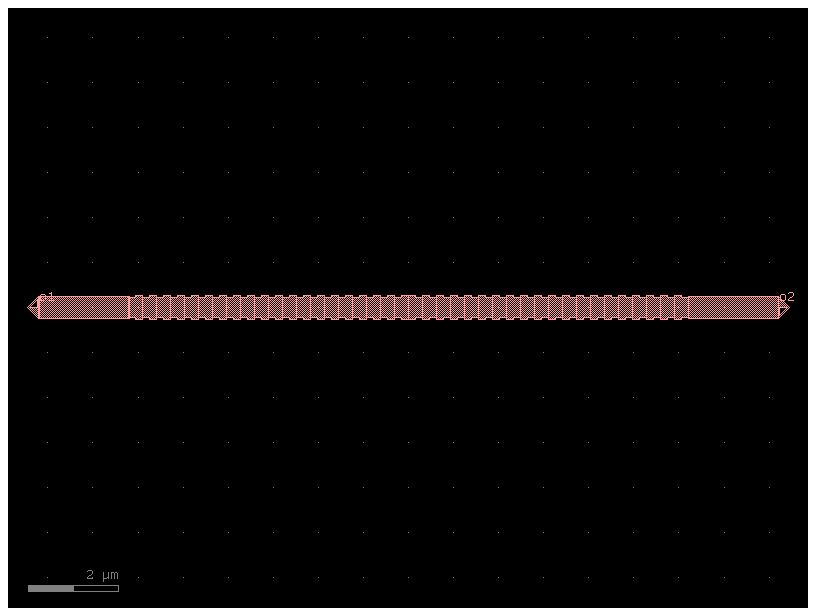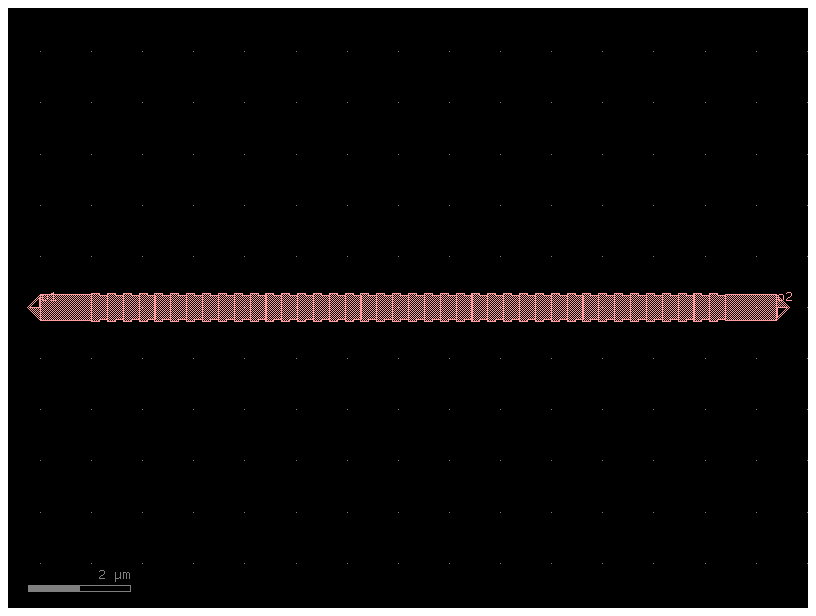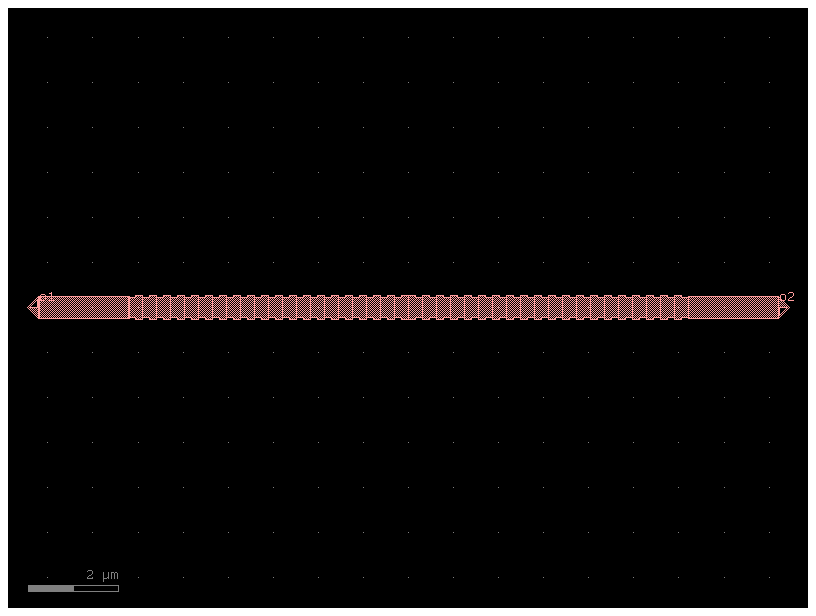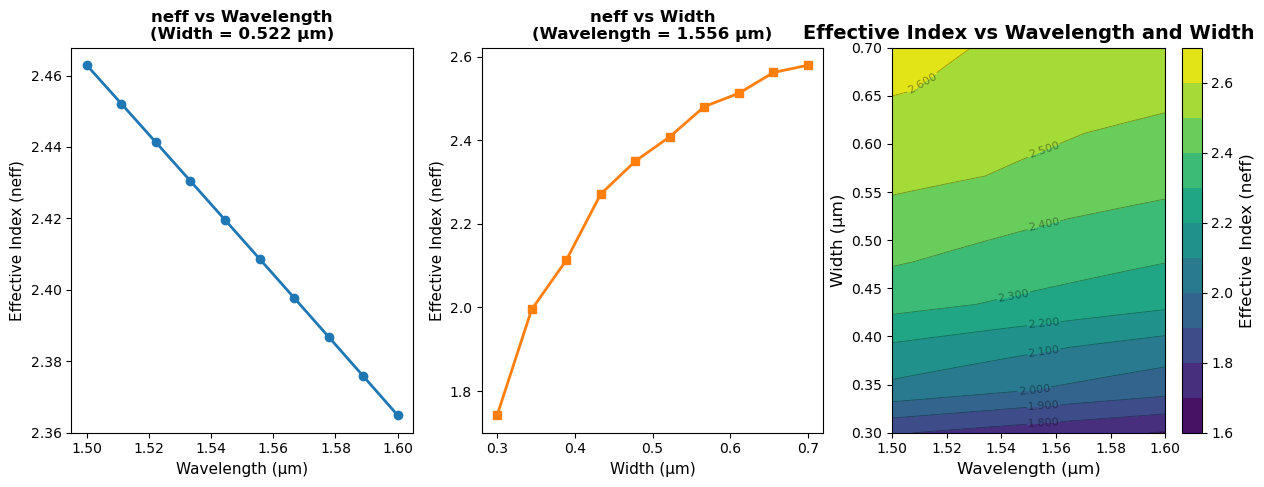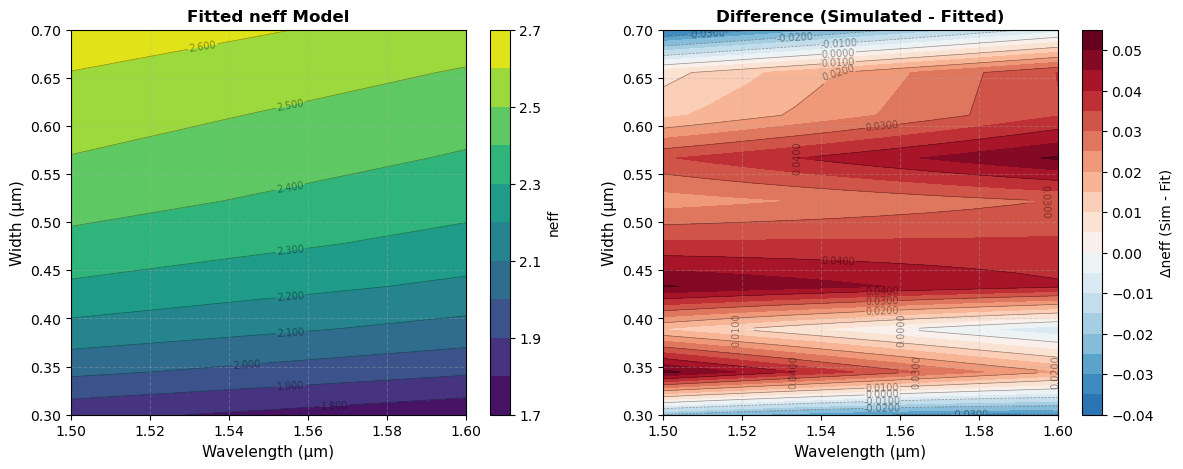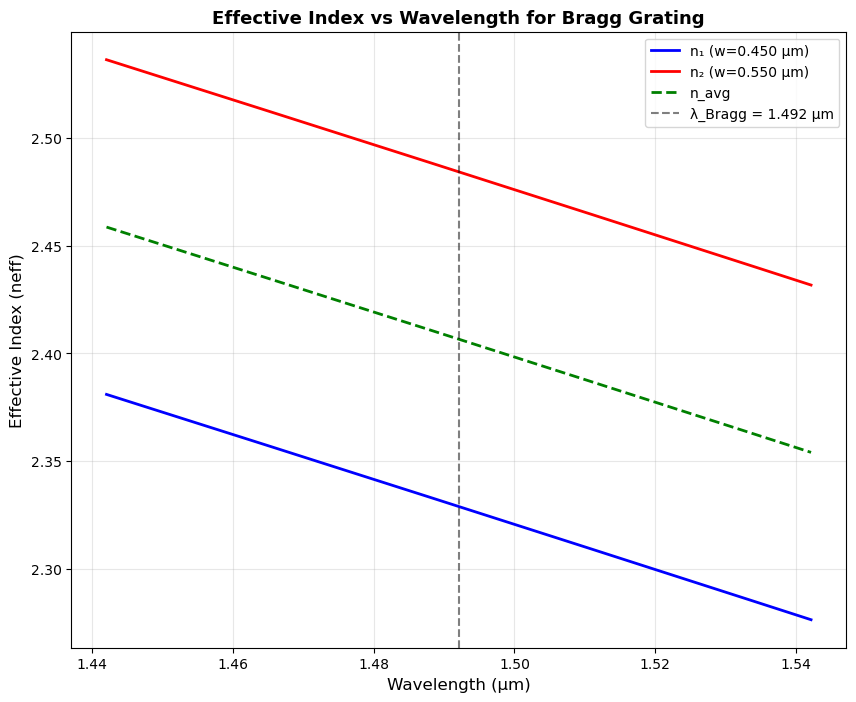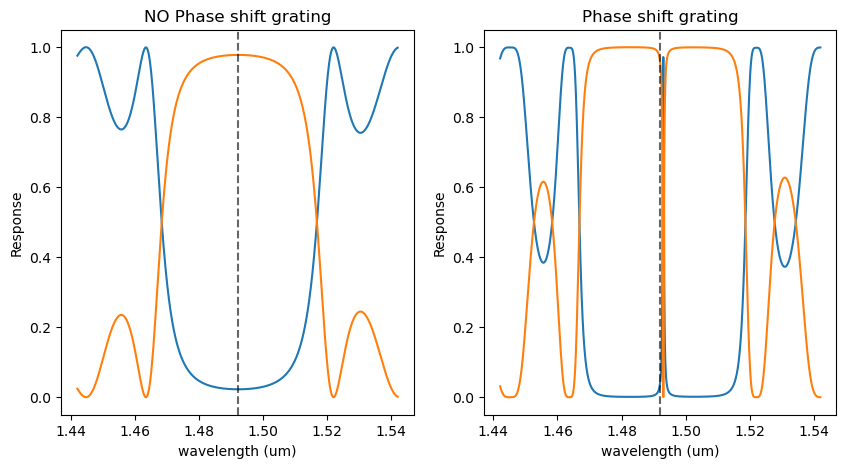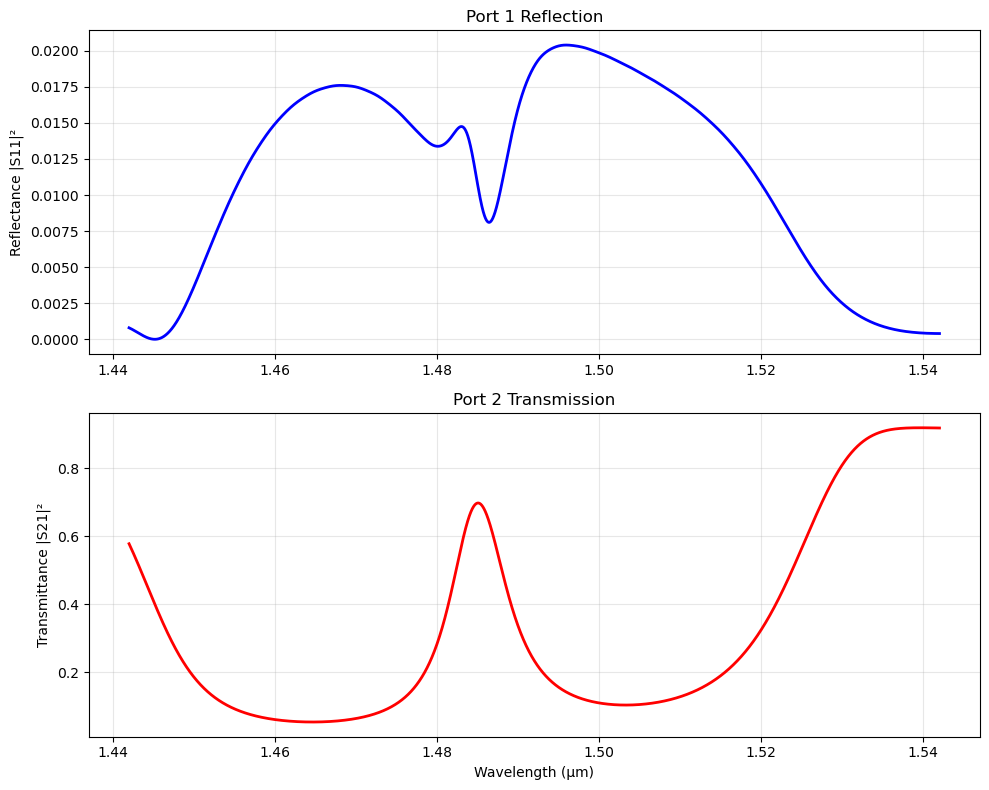Waveguide Bragg Grating
Waveguide Bragg Grating
Source Code
1
2
3
4
5
6
7
8
9
# Import necessary packages
import numpy as np
import matplotlib.pyplot as plt
import gdsfactory as gf
import meep as mp
import gplugins.gmeep as gm
import gdsfactory.cross_section as xs
import gplugins.modes as gmode
import pandas as pd
1
2
Using MPI version 4.1, 1 processes
[32m2025-10-14 18:14:51.010[0m | [1mINFO [0m | [36mgplugins.gmeep[0m:[36m<module>[0m:[36m39[0m - [1mMeep '1.31.0' installed at ['/home/ramprakash/anaconda3/envs/si_photo/lib/python3.13/site-packages/meep'][0m
Waveguide Bragg grating from GDS Factory
Source Code
1
2
3
4
5
6
7
8
9
10
11
12
13
14
15
wg_width = 0.5
delta_width=0.050
period = 0.310
length = period/2
NG=40
dbr = gf.components.dbr(
w1=wg_width+delta_width,
w2=wg_width-delta_width,
l1=length,
l2=length,
n=40,
straight_length=1).copy()
dbr.add_port(name='o2', center=(dbr.xmax, 0), width=wg_width, orientation=0,layer=(1,0))
dbr.draw_ports()
dbr.plot()
Phase shift DBR
Source Code
1
2
3
4
5
6
7
8
9
10
11
12
13
14
15
16
17
18
19
20
21
22
23
24
25
26
27
28
@gf.cell
def phase_shift_dbr(period = 0.310, n_period = 40, width1 = 0.55, width2 = 0.45):
# Create the two-segment unit cell of the DBR
length=period/2
dbr1 = gf.components.dbr(w1=width2,w2=width1,l1=length,l2=length,n=n_period/2,straight_length=0).copy()
dbr1.add_port(name='o2', center=(dbr1.xmax, 0), width=width1, orientation=0,layer=(1,0))
dbr2 = gf.components.dbr(w1=width1,w2=width2,l1=length,l2=length,n=n_period/2,straight_length=0).copy()
dbr2.add_port(name='o2', center=(dbr2.xmax, 0), width=width1, orientation=0,layer=(1,0))
straight = gf.components.straight(length=2, width=0.5)
phase_dbr = gf.Component()
dbr1_ref = phase_dbr.add_ref(dbr1)
dbr2_ref = phase_dbr.add_ref(dbr2)
straight1_ref = phase_dbr.add_ref(straight)
straight2_ref = phase_dbr.add_ref(straight)
dbr1_ref.connect("o2", dbr2_ref.ports["o1"], allow_width_mismatch=True)
straight1_ref.connect("o1", dbr2_ref.ports["o2"], allow_width_mismatch=True)
straight2_ref.connect("o2", dbr1_ref.ports["o1"], allow_width_mismatch=True)
return phase_dbr
gf.clear_cache()
pi_dbr = phase_shift_dbr().copy()
pi_dbr.add_port(name='o2', center=(pi_dbr.xmax, 0), width=0.5, orientation=0,layer=(1,0))
pi_dbr.add_port(name='o1', center=(pi_dbr.xmin, 0), width=0.5, orientation=180,layer=(1,0))
pi_dbr.draw_ports()
pi_dbr.plot()
Mode calculation
Get the effective index vs wavelength and width using mode calculation
Source Code
1
help(gmode.find_neff_vs_width)
1
2
3
4
5
6
7
8
9
10
11
12
13
14
15
16
17
18
19
20
21
22
23
24
25
26
27
28
29
30
31
32
33
Help on function find_neff_vs_width in module gplugins.modes.find_neff_vs_width:
find_neff_vs_width(
width1: 'float' = 0.2,
width2: 'float' = 1.0,
steps: 'int' = 12,
nmodes: 'int' = 4,
wavelength: 'float' = 1.55,
parity=0,
filepath: 'PathType | None' = None,
overwrite: 'bool' = False,
**kwargs
) -> 'pd.DataFrame'
Sweep waveguide width and compute effective index.
Args:
width1: starting waveguide width in um.
width2: end waveguide width in um.
steps: number of points.
nmodes: number of modes to compute.
wavelength: wavelength in um.
parity: mp.ODD_Y mp.EVEN_X for TE, mp.EVEN_Y for TM.
filepath: Optional filepath to store the results.
overwrite: overwrite file even if exists on disk.
Keyword Args:
slab_thickness: thickness for the waveguide slab in um.
core_material: core material refractive index.
clad_material: clad material refractive index.
sy: simulation region width (um).
sz: simulation region height (um).
resolution: resolution (pixels/um).
Source Code
1
help(gmode.find_modes)
1
2
3
4
5
6
7
8
9
10
11
12
13
14
15
16
17
18
19
20
21
22
23
24
25
26
27
28
29
30
31
32
33
34
35
36
37
38
39
40
41
42
43
44
45
46
47
48
49
50
51
52
53
54
55
56
57
58
59
60
61
62
63
64
65
66
67
68
69
70
71
72
73
74
75
76
77
78
79
80
81
82
83
84
85
86
87
88
89
90
91
92
93
94
95
96
97
98
99
100
101
102
103
104
105
106
107
108
109
110
111
112
113
114
Help on module gplugins.modes.find_modes in gplugins.modes:
NAME
gplugins.modes.find_modes - Compute modes of a rectangular Si strip waveguide on top of oxide. Note that you should only pay attention, here, to the guided modes, which are the modes whose frequency falls under the light line -- that is, frequency < beta / 1.45, where 1.45 is the SiO2 index.
DESCRIPTION
Since there's no special lengthscale here, you can just
use microns. In general, if you use units of x, the frequencies
output are equivalent to x/lambda# so here, the frequencies will be
output as um/lambda, e.g. 1.5um would correspond to the frequency
1/1.5 = 0.6667.
FUNCTIONS
find_modes_waveguide(
tol: float = 1e-06,
wavelength: float = 1.55,
mode_number: int = 1,
parity=0,
cache_path: str | pathlib._local.Path | None = PosixPath('/home/ramprakash/.gdsfactory/modes'),
overwrite: bool = False,
single_waveguide: bool = True,
**kwargs
) -> dict[int, gplugins.modes.types.Mode]
Computes mode effective and group index for a rectangular waveguide.
Args:
tol: tolerance when finding modes.
wavelength: wavelength in um.
mode_number: mode order of the first mode.
parity: mp.ODD_Y mp.EVEN_X for TE, mp.EVEN_Y for TM.
cache_path: path to cache folder. None to disable caching.
overwrite: forces simulating again.
single_waveguide: if True, compute a single waveguide. False computes a coupler.
Keyword Args:
core_width: core_width (um) for the symmetric case.
gap: for the case of only two waveguides.
core_widths: list or tuple of waveguide widths.
gaps: list or tuple of waveguide gaps.
core_thickness: wg height (um).
slab_thickness: thickness for the waveguide slab.
core_material: core material refractive index.
clad_material: clad material refractive index.
nslab: Optional slab material refractive index. Defaults to core_material.
ymargin: margin in y.
sz: simulation region thickness (um).
resolution: resolution (pixels/um).
nmodes: number of modes.
sidewall_angles: waveguide sidewall angle (radians),
tapers from core_width at top of slab, upwards, to top of waveguide.
Returns: Dict[mode_number, Mode]
compute mode_number lowest frequencies as a function of k. Also display
"parities", i.e. whether the mode is symmetric or anti_symmetric
through the y=0 and z=0 planes.
mode_solver.run(mpb.display_yparities, mpb.display_zparities)
Above, we outputted the dispersion relation: frequency (omega) as a
function of wavevector kx (beta). Alternatively, you can compute
beta for a given omega -- for example, you might want to find the
modes and wavevectors at a fixed wavelength of 1.55 microns. You
can do that using the find_k function:
single_waveguide=True
::
__________________________
|
|
| width
| <---------->
| ___________ _ _ _
| | | |
sz|_____| |_______|
| core_material | core_thickness
|slab_thickness nslab |
|_________________________|
|
| clad_material
|__________________________
<------------------------>
sy
single_waveguide=False
::
_____________________________________________________
|
|
| widths[0] widths[1]
| <----------> gaps[0] <---------->
| ___________ <-------------> ___________ _
| | | | | |
sz|_____| |_______________| |_____|
| core_material | core_thickness
|slab_thickness nslab |
|___________________________________________________|
|
|<---> <--->
|ymargin clad_material ymargin
|____________________________________________________
<--------------------------------------------------->
sy
DATA
PATH = <gdsfactory.config.Paths object>
PathType = str | pathlib._local.Path
find_modes_coupler = functools.partial(<function find_modes_waveguide ...
FILE
/home/ramprakash/anaconda3/envs/si_photo/lib/python3.13/site-packages/gplugins/modes/find_modes.py
Source Code
1
2
3
4
5
6
7
8
9
10
11
12
13
14
15
16
17
18
19
20
21
22
23
24
25
26
27
28
29
30
31
# using gmode based on MPB for width sweep and lamda sweep
mp.verbosity(0)
wavelengths = np.linspace(1.5, 1.6, 10)
# Initialize lists to store results
all_wavelengths = []
all_widths = []
all_neffs = []
for wavelength in wavelengths:
mode_width = gmode.find_neff_vs_width(width1=0.3,
width2=0.7,
steps=10,
nmodes=1,
wavelength=wavelength,
resolution=20,
sy=6,
sz=6,
core_material=3.45,
clad_material=1.45)
# Store results
for _, row in mode_width.iterrows():
all_wavelengths.append(wavelength)
all_widths.append(row['width'])
all_neffs.append(row[1])
df_results = pd.DataFrame({
'wavelength': all_wavelengths,
'width': all_widths,
'neff': all_neffs
})
Source Code
1
2
3
4
5
6
7
8
9
10
11
12
13
14
15
16
17
18
19
20
21
22
23
24
25
26
27
28
29
30
31
32
33
34
35
36
37
38
39
40
41
42
43
44
fig = plt.figure(figsize=(15, 5))
ax1 = plt.subplot(1, 3, 1)
unique_widths = sorted(df_results['width'].unique())
fixed_width = unique_widths[len(unique_widths)//2]
data = df_results[df_results['width'] == fixed_width]
ax1.plot(data['wavelength'], data['neff'], marker='o',
color='tab:blue', linewidth=2, markersize=6)
ax1.set_xlabel('Wavelength (µm)', fontsize=11)
ax1.set_ylabel('Effective Index (neff)', fontsize=11)
ax1.set_title(f'neff vs Wavelength\n(Width = {fixed_width:.3f} µm)',
fontsize=12, fontweight='bold')
ax2 = plt.subplot(1, 3, 2)
unique_wavelengths = sorted(df_results['wavelength'].unique())
fixed_wavelength = unique_wavelengths[len(unique_wavelengths)//2]
data = df_results[df_results['wavelength'] == fixed_wavelength]
ax2.plot(data['width'], data['neff'], marker='s',
color='tab:orange', linewidth=2, markersize=6)
ax2.set_xlabel('Width (µm)', fontsize=11)
ax2.set_ylabel('Effective Index (neff)', fontsize=11)
ax2.set_title(f'neff vs Width\n(Wavelength = {fixed_wavelength:.3f} µm)',
fontsize=12, fontweight='bold')
ax3 = plt.subplot(1, 3, 3)
pivot_data = df_results.pivot(index='width', columns='wavelength', values='neff')
levels = 10 # Number of contour levels
contourf = ax3.contourf(pivot_data.columns, pivot_data.index, pivot_data.values,
levels=levels, cmap='viridis')
contour = ax3.contour(pivot_data.columns, pivot_data.index, pivot_data.values,
levels=levels, colors='black', linewidths=0.5, alpha=0.4)
ax3.clabel(contour, inline=True, fontsize=8, fmt='%.3f')
cbar = plt.colorbar(contourf, ax=ax3)
cbar.set_label('Effective Index (neff)', fontsize=12)
ax3.set_xlabel('Wavelength (µm)', fontsize=12)
ax3.set_ylabel('Width (µm)', fontsize=12)
ax3.set_title('Effective Index vs Wavelength and Width', fontsize=14, fontweight='bold')
df_results.to_csv('WG_neff_lam_width.csv', index=False)
Using the curve fitted functions for effective index
$n_{neff-\lambda}(\lambda) = a_0-a_1(\lambda-\lambda_0)-a_2(\lambda-\lambda_0)^2$
$\Delta n_{neff-w}(w) = b_1(w-w_0)+b_2(w-w_0)^2-b_3(w-w_0)^3$
$n_{eff}(\lambda,w)=n_{eff-\lambda}(\lambda)+\Delta n_{neff-w}(w)$
The fit function is from book Silicon Photonics Design by Lukas Chrostowski and Michael Hochberg.
Source Code
1
2
3
4
5
6
7
8
9
10
11
12
13
14
15
16
17
18
19
20
21
22
23
24
25
26
27
28
29
30
31
32
33
34
35
36
37
38
39
40
41
42
43
44
45
46
47
48
49
50
51
52
53
54
55
56
57
58
59
60
61
62
63
64
65
66
67
68
69
70
71
72
73
74
75
76
77
78
79
80
81
82
83
# Coded with help of Claude.ai
df_results = pd.read_csv('WG_neff_lam_width.csv')
from scipy.optimize import curve_fit
lam0 = df_results['wavelength'].median()
w0 = df_results['width'].median()
print(f"\nReference points:")
print(f" λ₀ = {lam0:.4f} µm")
print(f" w₀ = {w0:.4f} µm")
# ============================================
# Step 2: Fit neff vs wavelength at reference width w0
# ============================================
print(f"\n{'='*60}")
print("STEP 1: Fitting neff(λ) at reference width w₀")
print("="*60)
# Get data at reference width (or closest width)
unique_widths = sorted(df_results['width'].unique())
w0_actual = min(unique_widths, key=lambda x: abs(x - w0))
data_at_w0 = df_results[df_results['width'] == w0_actual].sort_values('wavelength')
print(f"Using w = {w0_actual:.4f} µm (closest to w₀ = {w0:.4f} µm)")
# Define fitting function for wavelength dependence
def neff_lambda_func(lam, a0, a1, a2):
return a0 - a1*(lam - lam0) - a2*(lam - lam0)**2
# Fit the wavelength dependence
popt_lambda, pcov_lambda = curve_fit(
neff_lambda_func,
data_at_w0['wavelength'].values,
data_at_w0['neff'].values,
p0=[2.5, 1.0, 0.0] # Initial guess
)
a0, a1, a2 = popt_lambda
print(f"\nFitted parameters for neff(λ):")
print(f" a₀ = {a0:.6f}")
print(f" a₁ = {a1:.6f}")
print(f" a₂ = {a2:.6f}")
print(f"\nEquation: neff(λ) = {a0:.4f} - {a1:.4f}(λ - {lam0:.4f}) - {a2:.4f}(λ - {lam0:.4f})²")
# ============================================
# Step 3: Calculate neff at (λ0, w) for all widths
# ============================================
print(f"\n{'='*60}")
print("STEP 2: Calculating Δneff(w) - deviation from reference")
print("="*60)
# Get data at reference wavelength (or closest wavelength)
unique_wavelengths = sorted(df_results['wavelength'].unique())
lam0_actual = min(unique_wavelengths, key=lambda x: abs(x - lam0))
data_at_lam0 = df_results[df_results['wavelength'] == lam0_actual].sort_values('width')
print(f"Using λ = {lam0_actual:.4f} µm (closest to λ₀ = {lam0:.4f} µm)")
# Calculate the reference value neff_lambda(lam0)
neff_ref = neff_lambda_func(lam0_actual, a0, a1, a2)
print(f"Reference neff at (λ₀, w₀): {neff_ref:.6f}")
# Calculate deviation: Δneff(w) = neff(λ0, w) - neff(λ0, w0)
data_at_lam0['delta_neff'] = data_at_lam0['neff'].values - neff_ref
# Define fitting function for width dependence (deviation)
def delta_neff_w_func(w, b1, b2, b3):
return b1*(w - w0) + b2*(w - w0)**2 - b3*(w - w0)**3
# Fit the width dependence
popt_width, pcov_width = curve_fit(
delta_neff_w_func,
data_at_lam0['width'].values,
data_at_lam0['delta_neff'].values,
p0=[1.0, 0.0, 0.0] # Initial guess
)
b1, b2, b3 = popt_width
print(f"\nFitted parameters for Δneff(w):")
print(f" b₁ = {b1:.6f}")
print(f" b₂ = {b2:.6f}")
print(f" b₃ = {b3:.6f}")
print(f"\nEquation: Δneff(w) = {b1:.4f}(w - {w0:.4f}) + {b2:.4f}(w - {w0:.4f})² - {b3:.4f}(w - {w0:.4f})³")
1
2
3
4
5
6
7
8
9
10
11
12
13
14
15
16
17
18
19
20
21
22
23
24
25
26
27
28
Reference points:
λ₀ = 1.5500 µm
w₀ = 0.5000 µm
============================================================
STEP 1: Fitting neff(λ) at reference width w₀
============================================================
Using w = 0.4778 µm (closest to w₀ = 0.5000 µm)
Fitted parameters for neff(λ):
a₀ = 2.355873
a₁ = 1.058993
a₂ = 0.103059
Equation: neff(λ) = 2.3559 - 1.0590(λ - 1.5500) - 0.1031(λ - 1.5500)²
============================================================
STEP 2: Calculating Δneff(w) - deviation from reference
============================================================
Using λ = 1.5444 µm (closest to λ₀ = 1.5500 µm)
Reference neff at (λ₀, w₀): 2.361753
Fitted parameters for Δneff(w):
b₁ = 1.520782
b₂ = -4.093749
b₃ = -13.774246
Equation: Δneff(w) = 1.5208(w - 0.5000) + -4.0937(w - 0.5000)² - -13.7742(w - 0.5000)³
Source Code
1
2
3
4
5
6
7
8
9
10
11
12
13
14
15
16
17
18
19
20
21
22
23
24
25
26
27
28
29
30
31
32
33
34
35
36
37
38
39
40
41
42
43
44
45
46
47
48
49
50
51
52
53
54
55
56
57
58
59
60
61
lam0 = 1.550
w0 = 0.50
a0 = 2.355873
a1 = 1.058993
a2 = 0.103059
b1 = 1.520782
b2 = -4.093749
b3 = -13.774248
def neff_lambda(lam):
"""Calculate neff as function of wavelength"""
return a0 - a1*(lam - lam0) - a2*(lam - lam0)**2
def delta_neff_w(w):
"""Calculate delta neff as function of width"""
return b1*(w - w0) + b2*(w - w0)**2 - b3*(w - w0)**3
def neff_fitted(lam, w):
"""Calculate total fitted neff"""
return neff_lambda(lam) + delta_neff_w(w)
# Apply fitted model to all data points
df_results['neff_fitted'] = df_results.apply(
lambda row: neff_fitted(row['wavelength'], row['width']), axis=1
)
# Calculate difference (error)
df_results['neff_difference'] = df_results['neff'] - df_results['neff_fitted']
pivot_fit = df_results.pivot(index='width', columns='wavelength', values='neff_fitted')
pivot_diff = df_results.pivot(index='width', columns='wavelength', values='neff_difference')
levels = 10
fig = plt.figure(figsize=(14,5))
ax1 = plt.subplot(1, 2, 1)
contourf2 = ax1.contourf(pivot_fit.columns, pivot_fit.index, pivot_fit.values,
levels=levels, cmap='viridis')
contour2 = ax1.contour(pivot_fit.columns, pivot_fit.index, pivot_fit.values,
levels=levels, colors='black', linewidths=0.5, alpha=0.4)
ax1.clabel(contour2, inline=True, fontsize=7, fmt='%.3f')
cbar2 = plt.colorbar(contourf2, ax=ax1)
cbar2.set_label('neff', fontsize=10)
ax1.set_xlabel('Wavelength (µm)', fontsize=11)
ax1.set_ylabel('Width (µm)', fontsize=11)
ax1.set_title('Fitted neff Model', fontsize=12, fontweight='bold')
ax1.grid(True, alpha=0.3, linestyle='--')
ax2 = plt.subplot(1, 2, 2)
# Use diverging colormap for difference
max_diff = max(abs(pivot_diff.values.min()), abs(pivot_diff.values.max()))
contourf3 = ax2.contourf(pivot_diff.columns, pivot_diff.index, pivot_diff.values,
levels=20, cmap='RdBu_r', vmin=-max_diff, vmax=max_diff)
contour3 = ax2.contour(pivot_diff.columns, pivot_diff.index, pivot_diff.values,
levels=10, colors='black', linewidths=0.5, alpha=0.4)
ax2.clabel(contour3, inline=True, fontsize=7, fmt='%.4f')
cbar3 = plt.colorbar(contourf3, ax=ax2)
cbar3.set_label('Δneff (Sim - Fit)', fontsize=10)
ax2.set_xlabel('Wavelength (µm)', fontsize=11)
ax2.set_ylabel('Width (µm)', fontsize=11)
ax2.set_title('Difference (Simulated - Fitted)', fontsize=12, fontweight='bold')
ax2.grid(True, alpha=0.3, linestyle='--')
Calculate the spectrum using TMM.
Calculating effective index from the mode calculation.
Source Code
1
2
3
4
5
6
7
8
9
10
11
12
13
14
15
16
17
18
19
20
21
22
23
24
25
26
27
28
29
30
31
32
33
34
35
36
37
38
39
40
41
42
43
44
45
46
47
48
49
50
51
52
53
54
55
56
57
58
59
60
61
62
from scipy.optimize import fsolve
# Fit paramters
lam0 = 1.550
w0 = 0.50
a0 = 2.355873
a1 = 1.058993
a2 = 0.103059
b1 = 1.520782
b2 = -4.093749
b3 = -13.774248
# Grating parameters
period = 0.310 # Period of grating
NG = 50 # number of periods
L = NG*period # Grating length
width0 = 0.5 # Mean waveguide width
dwidth = 0.05 # +/- waveguide width
width1 = width0 - dwidth
width2 = width0 + dwidth
span = 0.100
Npoints = 1000
# Calculating the index of the thick and thin regions
def neff_lambda(lam):
"""Calculate neff as function of wavelength"""
return a0 - a1*(lam - lam0) - a2*(lam - lam0)**2
def delta_neff_w(w):
"""Calculate delta neff as function of width"""
return b1*(w - w0) + b2*(w - w0)**2 - b3*(w - w0)**3
def bragg_equation(lam):
"""Calcaute the Bragg Wavelength"""
neff_avg = neff_lambda(lam) + (delta_neff_w(width2)+delta_neff_w(width1))/2
return lam - period*2*neff_avg
wavelength0 = fsolve(bragg_equation, 1.55)[0]
wavelengths = wavelength0 + np.linspace(-span/2, span/2, Npoints)
# Calculate effective indices for both widths across wavelength range
n1 = neff_lambda(wavelengths) + delta_neff_w(width1) # neff for narrow width
n2 = neff_lambda(wavelengths) + delta_neff_w(width2) # neff for wide width
n_avg = (n1 + n2) / 2 # Average neff
fig, ax1 = plt.subplots(1, 1, figsize=(10, 8))
# Plot 1: Effective indices vs wavelength
ax1.plot(wavelengths, n1, 'b-', linewidth=2, label=f'n₁ (w={width1:.3f} µm)')
ax1.plot(wavelengths, n2, 'r-', linewidth=2, label=f'n₂ (w={width2:.3f} µm)')
ax1.plot(wavelengths, n_avg, 'g--', linewidth=2, label='n_avg')
ax1.axvline(wavelength0, color='black', linestyle='--', alpha=0.5,
label=f'λ_Bragg = {wavelength0:.3f} µm')
ax1.set_xlabel('Wavelength (µm)', fontsize=12)
ax1.set_ylabel('Effective Index (neff)', fontsize=12)
ax1.set_title('Effective Index vs Wavelength for Bragg Grating', fontsize=13, fontweight='bold')
ax1.legend(fontsize=10)
ax1.grid(True, alpha=0.3)
TMM code in python from the book Silicon Photonics Design by Lukas Chrostowski and Michael Hochberg
Source Code
1
2
3
4
5
6
7
8
9
10
11
12
13
14
15
16
17
18
19
20
21
22
23
24
25
26
27
28
29
30
31
32
33
34
35
36
37
38
39
40
41
42
43
44
45
46
47
48
49
50
51
52
53
54
55
56
57
58
59
60
61
62
63
64
65
66
67
68
69
70
71
72
73
74
75
76
77
78
79
80
81
82
83
84
85
86
87
88
89
90
91
92
93
94
95
96
97
98
99
100
101
102
103
104
105
106
107
108
109
110
111
112
113
114
115
116
117
118
119
120
121
122
123
124
125
126
127
128
129
130
131
132
133
134
135
136
137
138
139
140
141
142
143
144
145
146
147
import numpy as np
def TMM_HomoWG_Matrix(wavelength, l, neff, loss):
"""
Calculate the transfer matrix of a homogeneous waveguide.
Parameters:
-----------
wavelength : array_like
Wavelength array
l : float
Length of the waveguide
neff : array_like
Effective refractive index
loss : float
Loss parameter
Returns:
--------
T_hw : ndarray
Transfer matrix of shape (2, 2, len(neff))
"""
# Complex propagation constant
beta = 2 * np.pi * neff / wavelength - 1j * loss / 2
T_hw = np.zeros((2, 2, len(neff)), dtype=complex)
T_hw[0, 0, :] = np.exp(1j * beta * l)
T_hw[1, 1, :] = np.exp(-1j * beta * l)
return T_hw
def TMM_IndexStep_Matrix(n1, n2):
"""
Calculate the transfer matrix for an index step from n1 to n2.
Parameters:
-----------
n1 : array_like
Initial refractive index
n2 : array_like
Final refractive index
Returns:
--------
T_is : ndarray
Transfer matrix of shape (2, 2, len(n1))
"""
T_is = np.zeros((2, 2, len(n1)), dtype=complex)
a = (n1 + n2) / (2 * np.sqrt(n1 * n2))
b = (n1 - n2) / (2 * np.sqrt(n1 * n2))
T_is[0, 0, :] = a
T_is[0, 1, :] = b
T_is[1, 0, :] = b
T_is[1, 1, :] = a
return T_is
def TMM_Grating_Matrix(wavelength, Period, NG, n1, n2, loss, phase_shift=True):
"""
Calculate the total transfer matrix of the gratings.
Parameters:
-----------
wavelength : array_like
Wavelength array
Period : float
Grating period
NG : int
Number of grating periods
n1 : array_like
First refractive index
n2 : array_like
Second refractive index
loss : float
Loss parameter
Returns:
--------
T : ndarray
Total transfer matrix of shape (2, 2, len(wavelength))
"""
l = Period / 2
T_hw1 = TMM_HomoWG_Matrix(wavelength, l, n1, loss)
T_is12 = TMM_IndexStep_Matrix(n1, n2)
T_hw2 = TMM_HomoWG_Matrix(wavelength, l, n2, loss)
T_is21 = TMM_IndexStep_Matrix(n2, n1)
q = len(wavelength)
Tp = np.zeros((2, 2, q), dtype=complex)
T = np.zeros((2, 2, q), dtype=complex)
for i in range(q):
# Matrix multiplication in correct order
Tp[:, :, i] = (T_hw2[:, :, i] @ T_is21[:, :, i] @
T_hw1[:, :, i] @ T_is12[:, :, i])
# 1st order uniform Bragg grating
T[:, :, i] = np.linalg.matrix_power(Tp[:, :, i], NG)
# For an FP cavity, 1st order cavity, insert a high index region, n2
if phase_shift:
T[:, :, i] = (np.linalg.matrix_power(Tp[:, :, i], NG) @
T_hw2[:, :, i] @
np.linalg.matrix_power(Tp[:, :, i], NG) @
T_hw2[:, :, i])
return T
def TMM_Grating_RT(wavelength, Period, NG, n1, n2, loss, phase_shift=True):
"""
Calculate the R (reflectance) and T (transmittance) versus wavelength.
Parameters:
-----------
wavelength : array_like
Wavelength array
Period : float
Grating period
NG : int
Number of grating periods
n1 : array_like
First refractive index
n2 : array_like
Second refractive index
loss : float
Loss parameter
Returns:
--------
R : ndarray
Reflectance array
T : ndarray
Transmittance array
"""
M = TMM_Grating_Matrix(wavelength, Period, NG, n1, n2, loss, phase_shift)
q = len(wavelength)
T = np.abs(np.ones(q) / M[0, 0, :])**2
R = np.abs(M[1, 0, :] / M[0, 0, :])**2
return R, T
Spectrum of Bragg grating with phase shift and no phase shift
Source Code
1
2
3
4
5
6
7
8
9
10
11
12
13
14
15
16
17
18
19
20
21
loss_dBcm=3 # waveguide loss, dB/cm
loss=np.log(10)*loss_dBcm/10*100
R, T = TMM_Grating_RT(wavelength=wavelengths*10**-6, Period=period*10**-6, NG=40, n1=n1, n2=n2, loss=loss, phase_shift=False)
R_shift, T_shift = TMM_Grating_RT(wavelength=wavelengths*10**-6, Period=period*10**-6, NG=40, n1=n1, n2=n2, loss=loss, phase_shift=True)
fig = plt.figure(figsize=(10,5))
ax1 = plt.subplot(1,2,1)
ax1.plot(wavelengths, T)
ax1.plot(wavelengths,R)
ax1.axvline(wavelength0, color='black', linestyle='--',alpha=0.6)
ax1.set_title('NO Phase shift grating')
ax1.set_xlabel('wavelength (um)')
ax1.set_ylabel('Response')
ax2 = plt.subplot(1,2,2)
ax2.plot(wavelengths,T_shift)
ax2.plot(wavelengths,R_shift)
ax2.axvline(wavelength0, color='black', linestyle='--',alpha=0.6)
ax2.set_title('Phase shift grating')
ax2.set_xlabel('wavelength (um)')
ax2.set_ylabel('Response')
1
Text(0, 0.5, 'Response')
Model using MEEP
Source Code
1
2
3
4
5
6
7
8
9
10
11
12
13
14
15
16
17
18
19
20
21
22
23
24
25
26
27
28
29
30
31
32
33
34
35
36
37
38
39
40
41
42
43
44
45
46
47
48
49
50
51
52
53
54
55
56
57
58
59
60
61
62
63
64
65
66
67
68
69
70
71
72
73
74
75
76
77
78
79
80
81
82
83
84
85
86
87
88
89
90
91
92
93
94
95
96
97
98
99
100
101
102
103
104
105
106
107
108
109
110
111
112
113
114
115
116
117
118
119
120
121
122
123
124
125
126
127
128
129
130
131
132
133
134
135
136
137
138
139
140
141
142
143
144
145
146
147
148
149
150
151
152
153
154
155
156
157
158
159
160
161
162
163
164
165
166
167
168
169
170
%%writefile dbr_MPI_sim.py
import gplugins.modes as gmode
import numpy as np
import matplotlib.pyplot as plt
import meep as mp
import gdsfactory as gf
import gplugins.gmeep as gm
import gdsfactory.cross_section as xs
mp.verbosity(0)
wg_width = 0.5
delta_width=0.050
period = 0.310
length = period/2
NG=40
dbr = gf.components.dbr(
w1=wg_width+delta_width,
w2=wg_width-delta_width,
l1=length,
l2=length,
n=40,
straight_length=1).copy()
dbr.add_port(name='o2', center=(dbr.xmax, 0), width=wg_width, orientation=0,layer=(1,0))
# Set up frequency points for simulation
npoints = 10000
lcen = 1.492
dlam = 0.100
wl = np.linspace(lcen - dlam / 2, lcen + dlam / 2, npoints)
fcen = 1 / lcen
fwidth = 3 * dlam / lcen**2
fpoints = 1 / wl
# Center frequency mode_parity
mode_parity = mp.EVEN_Y + mp.ODD_Z
dpml = 1
dpad = 1
resolution = 80
# Define materials
Si = mp.Medium(index=3.45)
SiO2 = mp.Medium(index=1.45)
# Cell size
cell_size = mp.Vector3(dbr.xsize + 2 * dpml, dbr.ysize + 2 * dpml + 2 * dpad, 0)
# Create the ring resonator component
dbr = gf.components.extend_ports(dbr, port_names=["o1", "o2"], length=2)
dbr = dbr.copy()
dbr.flatten()
dbr.center = (0, 0)
# Get geometry from component
geometry = gm.get_meep_geometry.get_meep_geometry_from_component(dbr)
geometry = [
mp.Prism(geom.vertices, geom.height, geom.axis, geom.center, material=Si)
for geom in geometry
]
# Source
src = mp.GaussianSource(frequency=fcen, fwidth=fwidth)
source = [
mp.EigenModeSource(
src=src,
eig_band=1,
eig_parity=mode_parity,
eig_kpoint=mp.Vector3(1, 0, 0),
direction=mp.NO_DIRECTION,
size=mp.Vector3(0, 1),
center=mp.Vector3(dbr.ports["o1"].x + dpml + 2, dbr.ports["o1"].y),
amplitude=1
),
]
# Simulation
sim = mp.Simulation(
resolution=resolution,
cell_size=cell_size,
boundary_layers=[mp.PML(dpml)],
sources=source,
geometry=geometry,
default_material=SiO2,
# symmetries=[mp.Mirror(mp.Y)]
)
# Mode monitors
m1 = mp.Volume(
center=mp.Vector3(dbr.ports["o1"].x + dpml + 2 + 0.5, dbr.ports["o1"].y),
size=mp.Vector3(0, 1),
)
m2 = mp.Volume(
center=mp.Vector3(dbr.ports["o2"].x - dpml - 1 - 0.5, dbr.ports["o2"].y),
size=mp.Vector3(0, 1),
)
mode_monitor_1 = sim.add_mode_monitor(fpoints, mp.ModeRegion(volume=m1))
mode_monitor_2 = sim.add_mode_monitor(fpoints, mp.ModeRegion(volume=m2))
whole_dft = sim.add_dft_fields([mp.Ez], 0.6489713803621261, 0, 1, center=mp.Vector3(), size=cell_size)
# Only plot from master process
if mp.am_master():
print(f"Running simulation with {mp.count_processors()} MPI processes...")
sim.plot2D(labels=False)
plt.savefig('simulation_geometry.png', dpi=150, bbox_inches='tight')
plt.close()
# Run simulation
# sim.run(
# until_after_sources=mp.stop_when_fields_decayed(
# 25, mp.Ez, 1e-2
# )
# )
sim.run(
mp.at_every(2000, lambda sim: print(f"Time: {sim.meep_time():.1f}")),
until_after_sources=mp.stop_when_dft_decayed(tol=1e-9, maximum_run_time=10000)
)
# Calculate S parameters
norm_mode_coeff = sim.get_eigenmode_coefficients(
mode_monitor_1, [1], eig_parity=mode_parity
).alpha[0, :, 0]
port1_coeff = (
sim.get_eigenmode_coefficients(mode_monitor_1, [1], eig_parity=mode_parity).alpha[0, :, 1]
/ norm_mode_coeff
)
port2_coeff = (
sim.get_eigenmode_coefficients(mode_monitor_2, [1], eig_parity=mode_parity).alpha[0, :, 0]
/ norm_mode_coeff
)
# Get field data
eps_data = sim.get_epsilon()
ez_data = sim.get_dft_array(whole_dft, mp.Ez, 0)
# Save results (only from master process)
if mp.am_master():
np.save('dbr_wavelengths.npy', wl)
np.save('dbr_port1_coeff.npy', port1_coeff)
np.save('dbr_port2_coeff.npy', port2_coeff)
np.save('dbr_eps_data.npy', eps_data)
np.save('dbr_ez_data.npy', ez_data)
# Create field plot
fig = plt.figure(figsize=(12, 8))
ax_field = fig.add_subplot(1, 1, 1)
ax_field.set_title("Steady State Fields")
ax_field.imshow(
np.flipud(np.transpose(eps_data)),
interpolation="spline36",
cmap="binary"
)
ax_field.imshow(
np.flipud(np.transpose(np.real(ez_data))),
interpolation="spline36",
cmap="RdBu",
alpha=0.9,
)
ax_field.axis("off")
plt.savefig('dbr_steady_state_fields.png', dpi=150, bbox_inches='tight')
plt.close()
print("Simulation completed successfully!")
print(f"Results saved to: wavelengths.npy, port1_coeff.npy, port2_coeff.npy, eps_data.npy, ez_data.npy")
print(f"Plots saved to: simulation_geometry.png, steady_state_fields.png")
1
Overwriting dbr_MPI_sim.py
Source Code
1
!mpirun -np 24 python dbr_MPI_sim.py
1
2
3
4
5
6
7
8
9
/bin/bash: /home/ramprakash/anaconda3/envs/QE/lib/libtinfo.so.6: no version information available (required by /bin/bash)
Using MPI version 4.1, 24 processes
2025-10-14 18:43:06.283 | INFO | gplugins.gmeep:<module>:39 - Meep '1.31.0' installed at ['/home/ramprakash/anaconda3/envs/si_photo/lib/python3.13/site-packages/meep']
Running simulation with 24 MPI processes...
Simulation completed successfully!
Results saved to: wavelengths.npy, port1_coeff.npy, port2_coeff.npy, eps_data.npy, ez_data.npy
Plots saved to: simulation_geometry.png, steady_state_fields.png
Elapsed run time = 114.5774 s
For refelction 2 simulations are required to subtract the incident field. This requires two simulations with and the without the structure. This is not done here to save time.
Source Code
1
2
3
4
5
6
7
8
9
10
11
12
13
14
15
16
17
18
19
20
21
22
23
24
25
26
27
28
29
30
31
32
33
34
35
36
37
38
39
40
41
42
43
44
45
46
# Load results
wl = np.load('dbr_wavelengths.npy')
port1_coeff = np.load('dbr_port1_coeff.npy')
port2_coeff = np.load('dbr_port2_coeff.npy')
eps_data = np.load('dbr_eps_data.npy')
ez_data = np.load('dbr_ez_data.npy')
# Plot transmission spectrum
fig, (ax1, ax2) = plt.subplots(2, 1, figsize=(10, 8))
# S11 (reflection)
ax1.plot(wl, (np.abs(port1_coeff)**2), 'b-', linewidth=2)
ax1.set_ylabel('Reflectance |S11|²')
ax1.set_title('Port 1 Reflection')
ax1.grid(True, alpha=0.3)
# S21 (transmission)
ax2.plot(wl, (np.abs(port2_coeff)**2), 'r-', linewidth=2)
ax2.set_xlabel('Wavelength (μm)')
ax2.set_ylabel('Transmittance |S21|²')
ax2.set_title('Port 2 Transmission')
ax2.grid(True, alpha=0.3)
plt.tight_layout()
# plt.savefig('transmission_spectrum.png', dpi=150, bbox_inches='tight')
plt.show()
print(f"Peak transmission: {np.min(np.abs(port2_coeff)**2):.4f}")
print(f"Resonance wavelength: {wl[np.argmin(np.abs(port2_coeff)**2)]:.4f} μm")
fig = plt.figure(figsize=(12, 8))
ax_field = fig.add_subplot(1, 1, 1)
ax_field.set_title("Steady State Fields")
ax_field.imshow(
np.flipud(np.transpose(eps_data)),
interpolation="spline36",
cmap="binary")
ax_field.imshow(
np.flipud(np.transpose(np.real(ez_data))),
interpolation="spline36",
cmap="RdBu",
alpha=0.9,
)
ax_field.axis("off")
plt.show()
Phase shift DBR
Meep Modeling
Source Code
1
2
3
4
5
6
7
8
9
10
11
12
13
14
15
16
17
18
19
20
21
22
23
24
25
26
27
28
29
30
31
32
33
34
35
36
37
38
39
40
41
42
43
44
45
46
47
48
49
50
51
52
53
54
55
56
57
58
59
60
61
62
63
64
65
66
67
68
69
70
71
72
73
74
75
76
77
78
79
80
81
82
83
84
85
86
87
88
89
90
91
92
93
94
95
96
97
98
99
100
101
102
103
104
105
106
107
108
109
110
111
112
113
114
115
116
117
118
119
120
121
122
123
124
125
126
127
128
129
130
131
132
133
134
135
136
137
138
139
140
141
142
143
144
145
146
147
148
149
150
151
152
153
154
155
156
157
158
159
160
161
162
163
164
165
166
167
168
169
170
171
172
173
174
175
176
177
178
179
180
181
182
183
184
185
%%writefile pi_dbr_MPI_sim.py
import gplugins.modes as gmode
import numpy as np
import matplotlib.pyplot as plt
import meep as mp
import gdsfactory as gf
import gplugins.gmeep as gm
import gdsfactory.cross_section as xs
mp.verbosity(0)
wg_width = 0.5
delta_width=0.050
period = 0.310
length = period/2
NG=40
@gf.cell
def phase_shift_dbr(period = 0.310, n_period = 40, width1 = 0.55, width2 = 0.45):
# Create the two-segment unit cell of the DBR
length=period/2
dbr1 = gf.components.dbr(w1=width2,w2=width1,l1=length,l2=length,n=n_period/2,straight_length=0).copy()
dbr1.add_port(name='o2', center=(dbr1.xmax, 0), width=width1, orientation=0,layer=(1,0))
dbr2 = gf.components.dbr(w1=width1,w2=width2,l1=length,l2=length,n=n_period/2,straight_length=0).copy()
dbr2.add_port(name='o2', center=(dbr2.xmax, 0), width=width1, orientation=0,layer=(1,0))
straight = gf.components.straight(length=3, width=0.5)
phase_dbr = gf.Component()
dbr1_ref = phase_dbr.add_ref(dbr1)
dbr2_ref = phase_dbr.add_ref(dbr2)
straight1_ref = phase_dbr.add_ref(straight)
straight2_ref = phase_dbr.add_ref(straight)
dbr1_ref.connect("o2", dbr2_ref.ports["o1"], allow_width_mismatch=True)
straight1_ref.connect("o1", dbr2_ref.ports["o2"], allow_width_mismatch=True)
straight2_ref.connect("o2", dbr1_ref.ports["o1"], allow_width_mismatch=True)
return phase_dbr
gf.clear_cache()
pi_dbr = phase_shift_dbr().copy()
pi_dbr.add_port(name='o2', center=(pi_dbr.xmax, 0), width=0.5, orientation=0,layer=(1,0))
pi_dbr.add_port(name='o1', center=(pi_dbr.xmin, 0), width=0.5, orientation=180,layer=(1,0))
# Set up frequency points for simulation
npoints = 10000
lcen = 1.492
dlam = 0.100
wl = np.linspace(lcen - dlam / 2, lcen + dlam / 2, npoints)
fcen = 1 / lcen
fwidth = 3 * dlam / lcen**2
fpoints = 1 / wl
# Center frequency mode_parity
mode_parity = mp.EVEN_Y + mp.ODD_Z
dpml = 1
dpad = 1
resolution = 80
# Define materials
Si = mp.Medium(index=3.45)
SiO2 = mp.Medium(index=1.45)
# Cell size
cell_size = mp.Vector3(pi_dbr.xsize + 2 * dpml, pi_dbr.ysize + 2 * dpml + 2 * dpad, 0)
# Create the ring resonator component
pi_dbr = gf.components.extend_ports(pi_dbr, port_names=["o1", "o2"], length=2)
pi_dbr = pi_dbr.copy()
pi_dbr.flatten()
pi_dbr.center = (0, 0)
# Get geometry from component
geometry = gm.get_meep_geometry.get_meep_geometry_from_component(pi_dbr)
geometry = [
mp.Prism(geom.vertices, geom.height, geom.axis, geom.center, material=Si)
for geom in geometry
]
# Source
src = mp.GaussianSource(frequency=fcen, fwidth=fwidth)
source = [
mp.EigenModeSource(
src=src,
eig_band=1,
eig_parity=mode_parity,
eig_kpoint=mp.Vector3(1, 0, 0),
direction=mp.NO_DIRECTION,
size=mp.Vector3(0, 1),
center=mp.Vector3(pi_dbr.ports["o1"].x + dpml + 2, pi_dbr.ports["o1"].y),
amplitude=1
),
]
# Simulation
sim = mp.Simulation(
resolution=resolution,
cell_size=cell_size,
boundary_layers=[mp.PML(dpml)],
sources=source,
geometry=geometry,
default_material=SiO2,
# symmetries=[mp.Mirror(mp.Y)]
)
# Mode monitors
m1 = mp.Volume(
center=mp.Vector3(pi_dbr.ports["o1"].x + dpml + 2 + 0.5, pi_dbr.ports["o1"].y),
size=mp.Vector3(0, 1),
)
m2 = mp.Volume(
center=mp.Vector3(pi_dbr.ports["o2"].x - dpml - 1 - 0.5, pi_dbr.ports["o2"].y),
size=mp.Vector3(0, 1),
)
mode_monitor_1 = sim.add_mode_monitor(fpoints, mp.ModeRegion(volume=m1))
mode_monitor_2 = sim.add_mode_monitor(fpoints, mp.ModeRegion(volume=m2))
whole_dft = sim.add_dft_fields([mp.Ez], 0.6489713803621261, 0, 1, center=mp.Vector3(), size=cell_size)
# Only plot from master process
if mp.am_master():
print(f"Running simulation with {mp.count_processors()} MPI processes...")
sim.plot2D(labels=False)
plt.savefig('simulation_geometry.png', dpi=150, bbox_inches='tight')
plt.close()
# Run simulation
# sim.run(
# until_after_sources=mp.stop_when_fields_decayed(
# 25, mp.Ez, 1e-2
# )
# )
sim.run(
mp.at_every(2000, lambda sim: print(f"Time: {sim.meep_time():.1f}")),
until_after_sources=mp.stop_when_dft_decayed(tol=1e-9, maximum_run_time=10000)
)
# Calculate S parameters
norm_mode_coeff = sim.get_eigenmode_coefficients(
mode_monitor_1, [1], eig_parity=mode_parity
).alpha[0, :, 0]
port1_coeff = (
sim.get_eigenmode_coefficients(mode_monitor_1, [1], eig_parity=mode_parity).alpha[0, :, 1]
/ norm_mode_coeff
)
port2_coeff = (
sim.get_eigenmode_coefficients(mode_monitor_2, [1], eig_parity=mode_parity).alpha[0, :, 0]
/ norm_mode_coeff
)
# Get field data
eps_data = sim.get_epsilon()
ez_data = sim.get_dft_array(whole_dft, mp.Ez, 0)
# Save results (only from master process)
if mp.am_master():
np.save('pi_dbr_wavelengths.npy', wl)
np.save('pi_dbr_port1_coeff.npy', port1_coeff)
np.save('pi_dbr_port2_coeff.npy', port2_coeff)
np.save('pi_dbr_eps_data.npy', eps_data)
np.save('pi_dbr_ez_data.npy', ez_data)
# Create field plot
fig = plt.figure(figsize=(12, 8))
ax_field = fig.add_subplot(1, 1, 1)
ax_field.set_title("Steady State Fields")
ax_field.imshow(
np.flipud(np.transpose(eps_data)),
interpolation="spline36",
cmap="binary"
)
ax_field.imshow(
np.flipud(np.transpose(np.real(ez_data))),
interpolation="spline36",
cmap="RdBu",
alpha=0.9,
)
ax_field.axis("off")
plt.savefig('pi_dbr_steady_state_fields.png', dpi=150, bbox_inches='tight')
plt.close()
print("Simulation completed successfully!")
print(f"Results saved to: wavelengths.npy, port1_coeff.npy, port2_coeff.npy, eps_data.npy, ez_data.npy")
print(f"Plots saved to: simulation_geometry.png, steady_state_fields.png")
1
Overwriting pi_dbr_MPI_sim.py
Source Code
1
!mpirun -np 24 python pi_dbr_MPI_sim.py
1
2
3
4
5
6
7
8
9
10
11
/bin/bash: /home/ramprakash/anaconda3/envs/QE/lib/libtinfo.so.6: no version information available (required by /bin/bash)
Using MPI version 4.1, 24 processes
2025-10-14 18:34:23.919 | INFO | gplugins.gmeep:<module>:39 - Meep '1.31.0' installed at ['/home/ramprakash/anaconda3/envs/si_photo/lib/python3.13/site-packages/meep']
Running simulation with 24 MPI processes...
Warning: grid volume is not an integer number of pixels; cell size will be rounded to nearest pixel.
Warning: grid volume is not an integer number of pixels; cell size will be rounded to nearest pixel.
Simulation completed successfully!
Results saved to: wavelengths.npy, port1_coeff.npy, port2_coeff.npy, eps_data.npy, ez_data.npy
Plots saved to: simulation_geometry.png, steady_state_fields.png
Elapsed run time = 147.2282 s
For refelction 2 simulations are required to subtract the incident field. This requires two simulations with and the without the structure. This is not done here to save time
Source Code
1
2
3
4
5
6
7
8
9
10
11
12
13
14
15
16
17
18
19
20
21
22
23
24
25
26
27
28
29
30
31
32
33
34
35
36
37
38
39
40
41
42
43
44
45
46
# Load results
wl = np.load('pi_dbr_wavelengths.npy')
port1_coeff = np.load('pi_dbr_port1_coeff.npy')
port2_coeff = np.load('pi_dbr_port2_coeff.npy')
eps_data = np.load('pi_dbr_eps_data.npy')
ez_data = np.load('pi_dbr_ez_data.npy')
# Plot transmission spectrum
fig, (ax1, ax2) = plt.subplots(2, 1, figsize=(10, 8))
# S11 (reflection)
ax1.plot(wl, (np.abs(port1_coeff)**2), 'b-', linewidth=2)
ax1.set_ylabel('Reflectance |S11|²')
ax1.set_title('Port 1 Reflection')
ax1.grid(True, alpha=0.3)
# S21 (transmission)
ax2.plot(wl, (np.abs(port2_coeff)**2), 'r-', linewidth=2)
ax2.set_xlabel('Wavelength (μm)')
ax2.set_ylabel('Transmittance |S21|²')
ax2.set_title('Port 2 Transmission')
ax2.grid(True, alpha=0.3)
plt.tight_layout()
# plt.savefig('transmission_spectrum.png', dpi=150, bbox_inches='tight')
plt.show()
print(f"Peak transmission: {np.min(np.abs(port2_coeff)**2):.4f}")
print(f"Resonance wavelength: {wl[np.argmin(np.abs(port2_coeff)**2)]:.4f} μm")
fig = plt.figure(figsize=(12, 8))
ax_field = fig.add_subplot(1, 1, 1)
ax_field.set_title("Steady State Fields")
ax_field.imshow(
np.flipud(np.transpose(eps_data)),
interpolation="spline36",
cmap="binary")
ax_field.imshow(
np.flipud(np.transpose(np.real(ez_data))),
interpolation="spline36",
cmap="RdBu",
alpha=0.9,
)
ax_field.axis("off")
plt.show()
